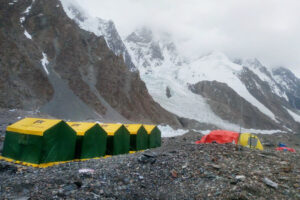And away we go. The push to the summit of winter K2 begins at 1 am Pakistan time (3 pm Eastern, 8 pm GMT today). At least 10 climbers, all from Nepal, will start up from Camps 3 and 4 simultaneously. According to Seven Summit Treks, they plan to top off in 12 hours. ExplorersWeb will continue to update throughout the day and night, as we get news.
In the order received from Seven Summit Treks, the climbers are Nirmal Purja, Gelje Sherpa, Mingma David Sherpa, Mingma G, Sona Sherpa, Mingma Tenzi Sherpa, Pem Chhiri Sherpa, Dawa Temba Sherpa, Kili Pemba Sherpa, and Dawa Tenjing Sherpa. Originally from three different teams, they have united in order to share the glory if they reach the top tomorrow.
For me, as a veteran climbing journalist, this historic attempt features a peculiar lack of information, missing details, and confusing or even contradictory facts that we’ll have to wait until everyone is back in Base Camp to parse out. For example, it is not clear who will leave from Camp 3 and who from Camp 4. Those at Camp 3 will have farther to go but may have been able to rest better at their lower, slightly less frigid altitude. The ones leaving from C4 will also have to break trail and fix ropes as they go, so will proceed much more slowly. The plan is that both teams will eventually join and share the work.
The second puzzle is, who is using oxygen and who is not? Mingma G has previously said that he will not. Nothing suggests that he’s changed his mind. So the added effort he will have to expend to keep pace with the rest of the powerful Sherpa team is enormous.
Nirmal Purja said last year that if he ever climbed K2 in winter, he would go no-O2. However, since confirming his participation here, he has said nothing on the matter. We just don’t know.
None of the other eight men have revealed his own choice, one way or the other. But since they are carrying loads and fixing ropes, it is reasonable to assume that they will use all the available resources.
In the end, the question is not just about using or not using O2, but when it is being used and at what flow rate. Such details might harbor the key to what makes this challenge perhaps not easy, but at least possible.
Forecasts agree on a nearly perfect summit day tomorrow. The following multi-model chart, as well as some other sources checked by ExplorersWeb, show that winds will pick on Sunday, though.

Forecast by Meteoexploration for the summit of K2 during the next two days.
The climbers will venture into a freezing night in nearly complete darkness: Tonight’s moon is a waxing crescent sliver, with only three percent peeking out from the shadows.
What to expect tonight
One of the leading experts on climbing K2, Ralf Dujmovits, has offered some insight on what may unfold in the hours ahead. But is it even possible to lead a summit push in winter, with no fixed ropes or broken trail? “Everything is possible with enough oxygen and the regulators at maximum flow,” says Dujmovits. “Nevertheless, the risks are high, and there is a very long way to the summit.”
First, the climbers have to progress through the avalanche-prone terrain around the Shoulder. Here, wind-driven snow builds up in the flatter areas, creating a hard slab on top that can let go at any moment. Those coming from Camp 3 will spend more time in that danger zone, in the dark. Those leaving from Camp 4 would be well advised, says Dujmovits, to fold their tents and mark the spot, because the relentless wind may bury the camp completely in drifted snow by the time they return.

The route from Camp 4: The Bottleneck and the Great Serac. Photo: Mingma G
The route gradually steepens as it approaches the Great Serac. Just below, they first have to climb the infamous Bottleneck, a narrow ice gully, then traverse to the left, right under the serac. You might think that the serac will be more stable in winter, but that’s not necessarily so. “Climbers must bear in mind that all that area will be bullet-proof blue ice,” says Dujmovits. “It will be essential to have a well-fixed rope or someone to belay the first climber. I once experienced that kind of ice on Denali very early in the season, and each step was a challenge.”
After the traverse, the terrain becomes technically easier but indescribably cold. They’ll be even more exposed to the wind and vulnerable to the altitude, whose effects are exacerbated by the even lower air pressure in winter. Then the summit, the brief sense of triumph…and the long descent back to life.






